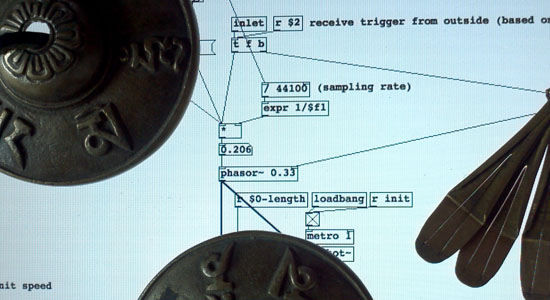PolySample [Pure Data]

I’ve been involved in a few projects recently where simultaneous multiple sound playback was needed. Working in the projects Syntonyms ( with Abris Gryllus and Marton Andras Juhasz ), SphereTones ( with Binaura ), and No Distance No Contact ( with Szovetseg39 ) repeatedly brought me the concept of playing overlapping sound samples. This means when you need to playback a sample and start playing it back again, before the previous instance has been finished. The Pure Data musical environment is really useful for low level sound manipulation, can be tweaked towards specific directions. I was searching the web for some solutions, but still didn’t find a really simple polyphonic sound sampler with adjustable pitch that is capable to play back multiple instances of the same sound if needed. For instance if you need to play long, resonating, vibrating sounds, it is useful to let the playback of the previous one finishing, so the next sound doesn’t interrupt it, but there are two instances of the same sound, both of them left decaying smooth & clear. Like raindrops or percussions, etc.
As a starting point I found myself again in the territories of dynamic patching. As you see on the video ( which is an older pd experiment of mine ) there are things that can be left to pd itself. Creating, deleting, connecting objects can be done quite easily by sending messages to pd itself. With PolySample, once the user creates a [createpoly] object, it automatically creates several samplers in itself. The number of generated samplers can be given as a second argument to the object. First argument is the name of the sound file to be played back. There is an optional third argument for changing the sampling rate ( which is 44100 by default ). It is useful when working with libPd and the like, where different devices and tablets operate on a lower sampling rate. So creating a sampler can be invoked as
[ createPoly < sound filename > < numberOfPolyphony > < sample rate > ]
The first inlet of the object accepts a list: the first element is the pitch, the second element is the volume of the actual sample to be played. This is useful when trying to mimic string instruments or really dynamic range of samples. This volume sets the initial volume of each sample ( within the polyphony ), whereas the second inlet accepts a float for controlling the overall sound, as a mixer.
You can create as many polyphonic samplers as you wish ( keep in mind that smaller processors can be freaked out quite quickly if you create tons of sample buffers at the same time ). The project is available at Github, here.
Built with Pd Vanilla, should work with libPd, webPd, RJDJ and other embeddable Pd projects.